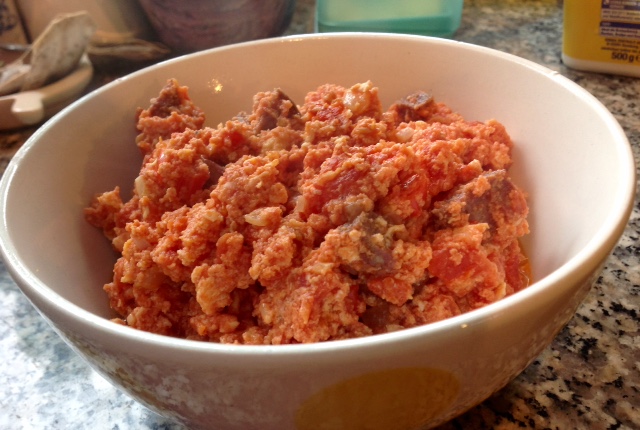When I was in Istanbul in late September, our hostess took us out for breakfast. I asked for a recommendation, and got Menemen, a so-called spicy dish, because of the garlic, chili peppers, and Turkish salami in it. It only made me smile. Hey, I’ve had Korean kimchi for breakfast.
The next morning, I got a cooking lesson from our hostess. Thank you, Gönül T.

Menemen
This is so easy to make with every-day ingredients. We always have onions and garlic at home. I keep dried peppers on the window sill, and I bought a can of pureed tomatoes from the supermarket. The only extra trip we had to make was to the Turkish market for the special salami (Pastırma or Sucuk). This sausage will last at least for four makings of Menemen.
Ingredients:
* 1/2 an onion and one garlic clove
* one can of pureed or diced tomatoes (400 g or 14 oz)
* two large or three small eggs
* shredded cheese of any kind. Feta cheese can also be used.
Directions:
1. Sauté both chopped garlic and onions until tender.
2. Add can of pureed tomatoes. Let simmer for about 10 -15 minutes until most of the liquid has evaporated.
3. Add sliced chili peppers (dried or fresh).
4. Scramble two large eggs in a separate bowl and slowly add to the simmering mix. Let sit and simmer for another 5 – 10 minutes to make sure the egg within the mix is fully cooked.
5. Add quartered slices of Sucuk or Pastırma (Turkish salami).
6. Stir in the shredded cheese or Feta cubes and after another minute or two of melting, it’s done.
This has become a regular brunch around our home since September of this year. Serve with sliced pieces of French bread. It tastes good warm or cold.
I know there are other versions of this dish – with eggs sunny side up, swimming in the tomato mix. I’ve been told this is the more southern version.
The Turkish family name Menemenci comes from ‘the one who makes Menemen’. The name can be passed on down the family line – to the name Menemencioglu (son of Menemenci).





